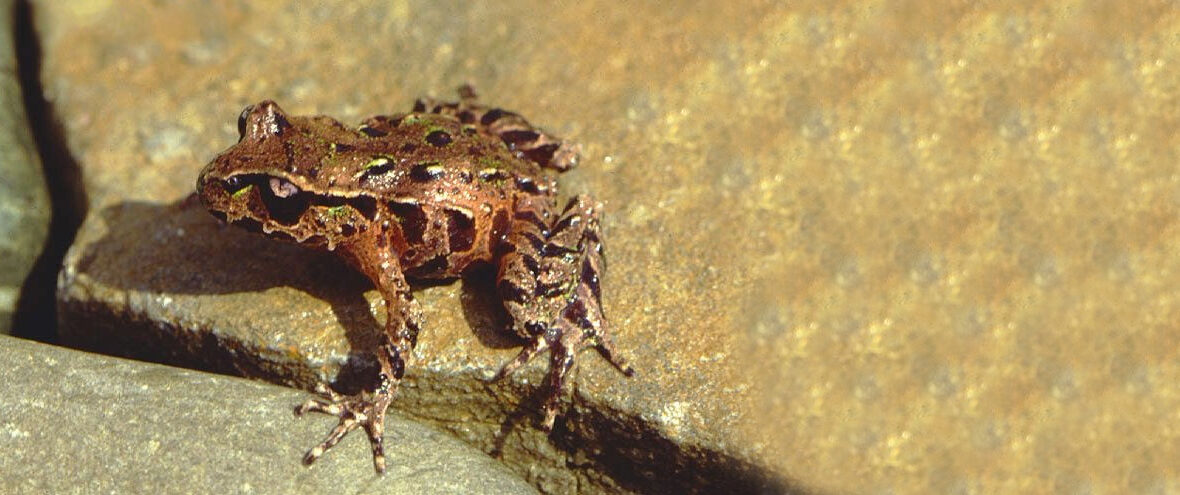
The Archey’s frog has changed little over the past 200 million years, therefor they represent “living fossils”. They prefer the damp vegetation of their native forests, and dwell only in a small section of forest in the North Island of New Zealand. Sadly due to habitat destruction at the hands of the logging industry and mining efforts; and invasive species (and with them disease, competition for food, and predation), these frogs are listed as Critically Endangered by the IUCN.
First the Stats…
Scientific name: Leiopelma archeyi
Weight: Up to .14 ounce
Length: Up to 1.46 inches
Lifespan: Up to 40 years
Now on to the Facts!
1.) As of 2015 their populations were stable at just 20,000 wild individuals.
2.) The tiny little frogs are only found in the Coromandel Peninsula and near Te Kūiti in the North Island of New Zealand.
3.) These frogs are missing several features found in most other frogs. They don’t have free ribs (ribs that are not fused to the vertebrae), they also don’t possess external eardrums, and they don’t croak.
4.) Like most frogs, they are nocturnal (active at night).
5.) Various insects, spiders, and worms make up their diet.
But wait, there’s more on the Archey’s frog!
6.) They are completely terrestrial (spend their life on the ground). These frogs lack webbing on their forelimbs and hind limbs.
7.) Females lay up to 19 eggs from December – February.
Did you know…?
The Archey’s frog is named after the former director of the Auckland Institute, Sir Gilbert Archey.
8.) Males are responsible for not only building the nest, but for guarding the eggs, secreting antimicrobial peptides onto them to ensure successful embryonic development.
9.) Archey’s frogs undergo direct development. This means that they hatch from eggs as tiny frogs, bypassing the aquatic tadpole stage completely.
10.) Upon hatching, the tailed froglets will crawl onto the male’s back and are then carried around for several weeks until they complete their metamorphosis.
But wait, there’s still more on the Archey’s frog!
11.) With their small population size, limited range of habitat, threats from predators, and habitat loss these are 1 of New Zealand’s most vulnerable frog species.
12.) There are numerous conservation programs underway to protect the Archey’s frog. These include predator control, habitat restoration, and ex situ (captive) breeding programs.
Did you know…?
While vocalizations are only given when threatened, these frogs normally communicate via chemical signalling.
13.) These frogs are just 1 of only 3 extant species belonging to the taxonomic family Leiopelmatidae.
14.) The mottled colors of green, red, and brown on their skin provide them with superb camouflage, allowing them to blend in with the forest floor and avoid predators.
15.) These frogs are not sexually dimorphic (males and females look different), but rather considered monomorphic (males and females look alike). This makes it rather difficult to sex the creatures for demographic purposes.
But wait, there’s still a tad more on the Archey’s frog!
16.) Cats, hedgehogs, ferrets, rats, feral pigs, and the introduced green and golden bell frogs all prey on these little frogs. Goats, deer, and pigs also trample and consume the forest vegetation used by these frogs, destroying their habitat further.
17.) Experimental infections of Archey’s frogs have shown that they produce antimicrobial peptides that help to inhibit the growth of the deadly chytrid fungus. These frogs do not show any clinical symptoms.
18.) During the ex situ breeding program at the Auckland Zoo, Otago University, and James Cook University the breeding populations ended up not surviving due to metabolic bone disease (MBD). This is a disease that is brought about by a lack of appropriate calcium and vitamin D in their diet.
Now a Short Archey’s Frog Video!
Be sure to share & comment below! Also, check out the Critter Science YouTube channel. Videos added regularly!
Want to suggest a critter for me to write about? Let me know here.
Some source material acquired from: Wikipedia & IUCN
Photo credit: David M. Green



